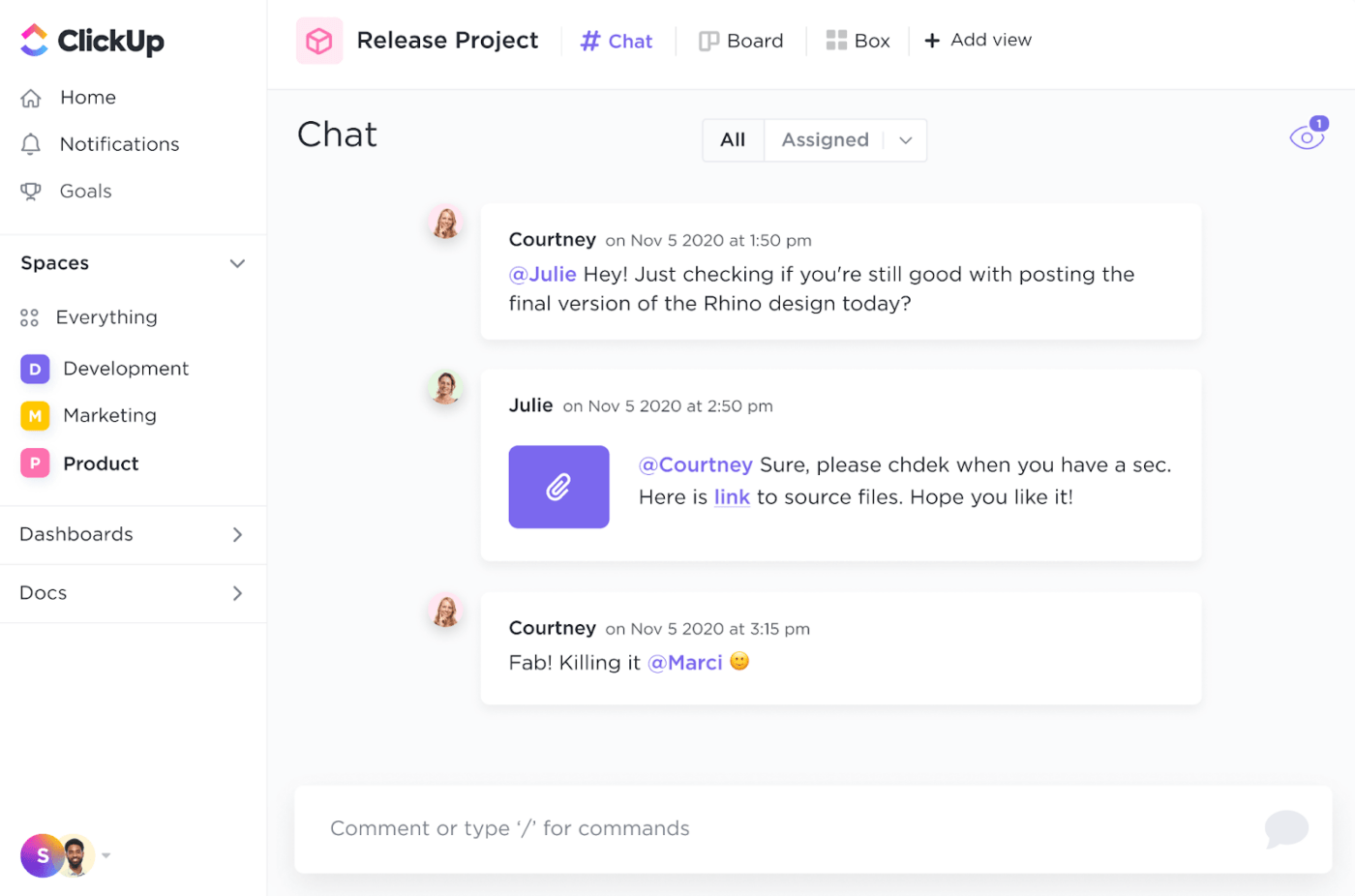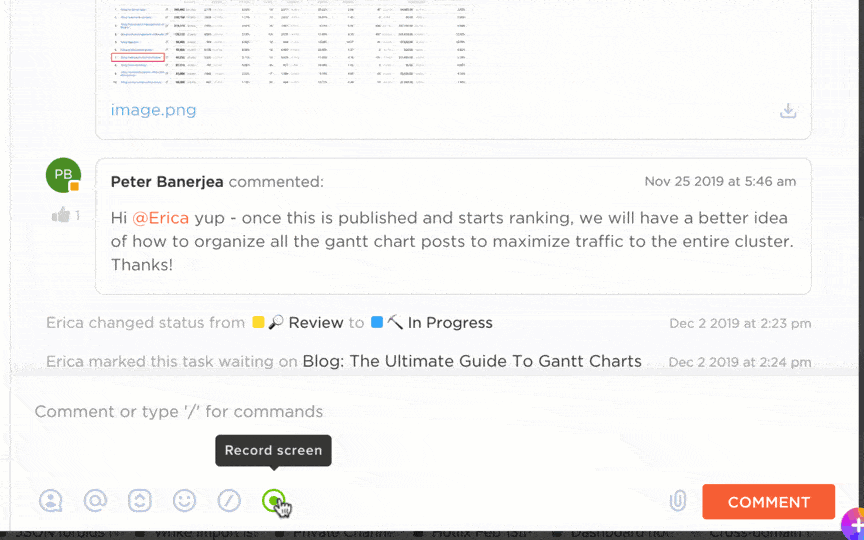How to Improve Hybrid Workplace Communication

Sorry, there were no results found for “”
Sorry, there were no results found for “”
Sorry, there were no results found for “”
Work from your couch when the commute is too long, or you need quiet focus. Head to the office when working remotely gets lonely or boring. A hybrid work environment does sound like a win-win, right?
But not all is perfect with this work arrangement. One of the top issues is—hybrid workplace communication.
Communication in a hybrid workplace refers to exchanging information and ideas between remote employees and those in a physical office.
In a hybrid workplace, physical distance creates hurdles for collaboration and understanding.
Effective communication bridges this gap. It’s crucial for maintaining productivity, collaboration, and team cohesion. It minimizes misunderstandings, strengthens relationships, leads to better decisions, and keeps remote workers engaged.
The hybrid communication model may combine synchronous and asynchronous communication methods to ensure everyone feels connected and informed, regardless of location.
If you’re curious how this comes to be, let’s dive into the workings of a hybrid workplace, developing effective communication strategies and overcoming barriers with some of the best collaboration and communication tools!
Hybrid communication refers to using synchronous and asynchronous communication methods to connect effectively with remote and in-office employees in a workplace.
For example, in a hybrid work environment, a marketing team might use a video conferencing platform for a morning stand-up meeting to discuss project updates (synchronous). They may collaborate on documents or brainstorm ideas throughout the day using a shared workspace tool (asynchronous).
This is remarkably different from traditional workplace communication, where all employees are often in the same building and, sometimes, even in the same room. You can simply walk up to colleagues to discuss things and hold in-person meetings without being dependent on a video conferencing tool.
Here are the key differences between traditional workplace communication and hybrid communication:
| Feature | Traditional workplace communication | Hybrid workplace communication |
| Dominant work location | Primarily in-office | A mix of in-office and remote |
| Communication channels | Mostly face-to-face meetings and phone calls | Combines face-to-face interaction with video conferencing and collaboration tools |
| Information flow | Relies on physical presence and scheduled meetings | May be synchronous (real-time) or asynchronous (non-concurrent work) |
| Collaboration style | Primarily in-person brainstorming sessions with shared whiteboards | Uses a mix of in-person and virtual collaboration tools |
| Accessibility | Limited to those physically present | Can include geographically dispersed teams |
One of the main differences between traditional and hybrid communication is the reliance on technology.
Hybrid workplaces use digital tools to facilitate communication and real-time collaboration between remote and in-office employees, fostering flexibility and improving efficiency. This is especially helpful for remote employees who don’t have access to in-office resources.
Hybrid communication isn’t limited explicitly to remote work, but it becomes crucial in a hybrid work environment for a few key reasons:
Now that you understand the importance of hybrid communication let’s explore how to bridge communication gaps in such workplaces!
A communication gap in a hybrid workplace is where information or ideas fail to flow effectively between employees. This can lead to misunderstandings, decreased productivity, and isolation for remote workers.
For instance, your marketing team brainstorms a campaign in the office using a physical whiteboard. A remote team member may join virtually but may not be able to see the board well and contribute ideas.
Several factors cause communication gaps like this one. They can severely harm the company culture and employee productivity.
Here’s how communication gaps arise in a hybrid workplace and the negative consequences they bring:
1. Limited in-person interaction
Cause: The lack of spontaneous conversations and hallway discussions that happen naturally in an office can hinder information sharing and idea exchange between remote and in-office teams.
Effect: This can lead to duplicated efforts and a general feeling of being out of the loop for remote workers.
2. Mismatch of communication channels
Cause: Reliance on just emails or messaging platforms can lead to misunderstandings due to the absence of non-verbal cues. In-office discussions might not be well-documented or shared with remote colleagues, creating information silos.
Effect: This can result in frustration, wasted time spent clarifying details, and ultimately, missed opportunities.
3. Unclear communication policies
Cause: Without clear guidelines on communication tools, response times, and meeting etiquette, confusion reigns. Remote workers might not know the best way to reach colleagues or hesitate to interrupt in-office discussions.
Effect: This leads to an environment where people are unsure how to collaborate best, leading to disengagement and a decline in team spirit.
4. Technological hiccups
Cause: Technical difficulties during video conferences or malfunctioning collaboration tools can disrupt workflows and leave remote workers feeling excluded.
Effect: This can lead to missed information or decisions and a decline in trust and collaboration across the team.
The good news? Every problem has a solution, and these challenges can be solved with time-tested communication strategies!
Using communication and remote collaboration tools and implementing a dedicated strategy will help you build a hybrid workplace that thrives and positively impacts the company’s bottom line.
Here are some ways to bridge the communication gaps you might face in a hybrid culture:
1. Embrace a mix of communication tools
2. Establish clear communication guidelines
3. Foster inclusivity in meetings
4. Use technology for collaboration
5. Bridge the physical distance
You know how to overcome the trickiest challenges in hybrid workplace communication. And with the help of your colleagues, you’ll feel empowered and supported to take them in your stride!
Working remotely half the time can create a sense of disruption, but colleagues can also help build social support.
Social support in a hybrid workplace fosters a positive and productive work environment for both remote and in-office employees. Here’s how:
And since social support is so essential in a hybrid work model, you must employ specific techniques to ensure your employees build connections in the workplace.
Fruitful connections and impactful mentorship take time to build. However, this investment will truly be worth your time, and here’s how you can help your employees:
In a hybrid workplace, physical distance can create a barrier to building employee connections.
Virtual team discussions and focus groups offer powerful tools to bridge this gap.
Organize periodic virtual focus group discussions to gather feedback, insights, and ideas from a cross-section of employees. These discussions can help leaders understand their workforce’s evolving needs, concerns, and preferences.
They create a platform for open dialogue, where employees can voice their opinions, suggest improvements, and feel heard.
Brainstorming sessions and project updates provide a platform for shared ideas and open communication. Remote team members can actively participate, ask questions, and contribute their perspectives.
Two-way interactions build trust and rapport, like conversations around a traditional office’s water cooler. Discussing topics relevant to your hybrid workforce can spark empathy and understanding and unearth valuable suggestions and solutions.
Staying connected in a hybrid work environment requires intentionality, but the rewards are worth it—a more engaged and productive workforce.
Use video conferencing for meetings, instant messaging for quick updates, and project management tools for ongoing collaboration that cater to different work styles. Ensure that important information, decisions, and updates are shared consistently with both remote and in-office employees.
Create a space for employees to share personal updates, hobbies, or interests. This can spark conversations and build connections.
Schedule periodic in-person team gatherings, such as quarterly or annual offsites, to allow remote and in-office employees to connect and collaborate face-to-face. These in-person meetings can strengthen interpersonal bonds, facilitate deeper discussions, and reinforce the team’s shared purpose and culture.
Use AI and team communication tools for document editing, brainstorming, and project management. This fosters a sense of working together, even when physically apart.
Now, let’s dive into some common challenges you must be prepared to face if you opt for a hybrid work model for your company!
When you have some permanent remote workers and others coming to the office for a few days a week, timelines, productivity, and even positivity can go for a toss. Let’s address the most common challenges you’ll see in a hybrid work environment:
Don’t be discouraged. You can mitigate these roadblocks with tools that bridge communication or collaboration gaps.
Wondering if you’ll need multiple tools to solve hybrid communication problems? Not really.
Consider ClickUp as your hybrid or remote project management software! This is the only tool you need to tackle the challenges of hybrid workplace communication and create a winning communication and collaboration strategy.

Use ClickUp’s Remote Project Management Software to manage remote or hybrid work environments. Here’s a detailed breakdown of all the features that you can use to create the perfect working dynamic for your team:
The perfect tool to visualize any brainstorming session is the ClickUp Communications Plan Whiteboard Template. Use this whiteboard template to:

Want a simple, quick way to talk to your team members, whether in the office or while working remotely? You don’t want to be intrusive but want to get work done. And, most of all, you want a professional platform—so you don’t intrude on their work-life balance.
ClickUp Chat view can help. Communicate async or in real time on one or multiple projects without breaking a sweat.

Need to share a quick explanation or instruction that can’t be conveyed via plain text? Use ClickUp Clips, ClickUp’s handy screen recording and video messaging feature. Capture your screen or record a short video message directly within ClickUp to provide clear instructions or updates, even when team members are offline.
You can share this on chats or email the video links without leaving ClickUp or switching between various tools.
Bonus: Establishing an effective communication method at a hybrid workplace takes time, so we’ve devised an easy fix.
ClickUp’s Communication Matrix Report Template provides a clear overview of your organization’s communication channels, eliminating confusion and streamlining processes.
Here are its benefits:

While async communication is great, it may not work when you must get things done urgently and collaboratively. For such cases, you’ve got ClickUp Docs. Docs help you create and edit documents with your team members in real time.
Use this powerful collaboration feature to:
If you still need a comprehensive communication plan that sticks, try ClickUp’s Communication Plan Template.
Cut through the noise to build and execute a clear, actionable plan that strengthens internal and external communication.
The template streamlines the process by helping you:
Now, what does the future hold for thriving hybrid workplaces? Let’s read about future trend drops and how ClickUp can help you there, too!
The future of hybrid workplace communication is about bridging the gap between in-person and remote teams. Here are some key trends and how ClickUp can help your team navigate them:
Effective hybrid communication isn’t just about sending messages; it’s about fostering a connected and engaged workforce, regardless of location.
By embracing asynchronous communication and visual collaboration tools and focusing on accessibility, you can bridge the physical and digital divide, empowering your team to thrive in the hybrid landscape.
ClickUp steps in as your communication and collaboration champion. Its comprehensive suite of features tackles the challenges of current and future hybrid work head-on, promoting transparency, streamlining workflows, and fostering a strong team culture.
Sign up for ClickUp today and see it for yourself!
Communicating in a hybrid work model requires intentionality. To stay connected, use a mix of video calls, instant messaging, and regular check-ins. Be mindful of time zones and ensure everyone is included, whether they’re in the office or working remotely.
Building connections in a hybrid workplace takes effort. Schedule virtual coffee breaks, organize team-building activities, and encourage casual conversations. Leverage technology to foster social interaction and create community, even when teammates aren’t physically together.
Effective remote communication relies on clear, concise, and proactive messaging. To stay aligned, use video conferencing, instant messaging, and project management tools. Provide frequent updates, ask questions, and be responsive to maintain transparency and productivity.
© 2025 ClickUp